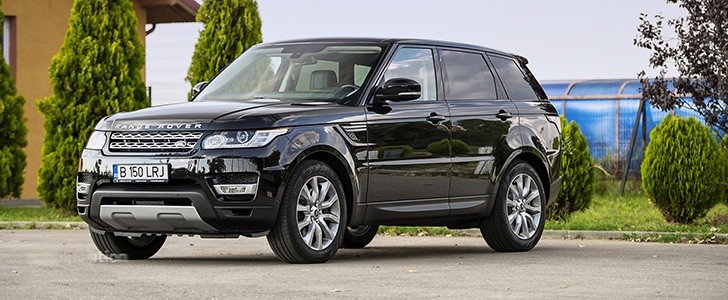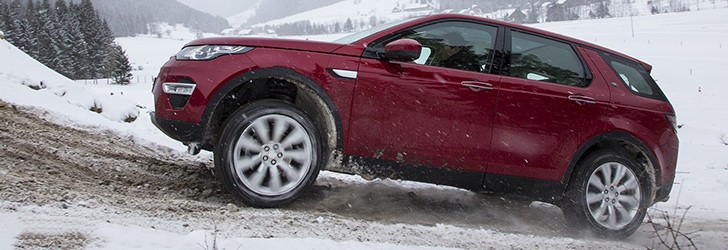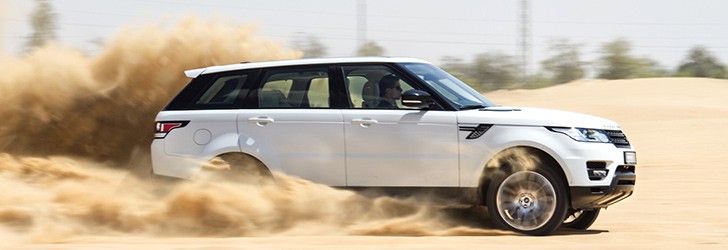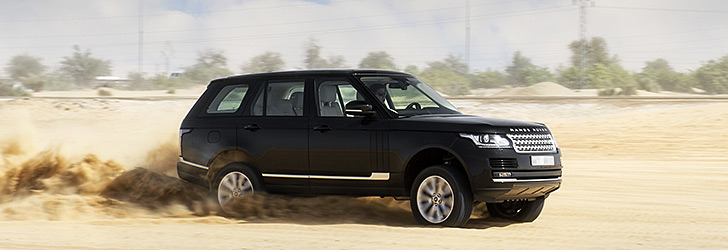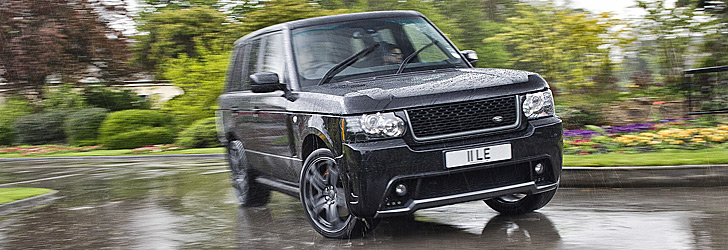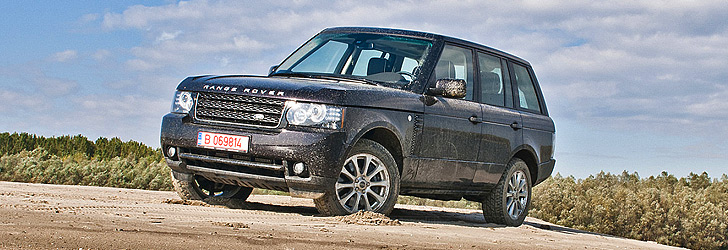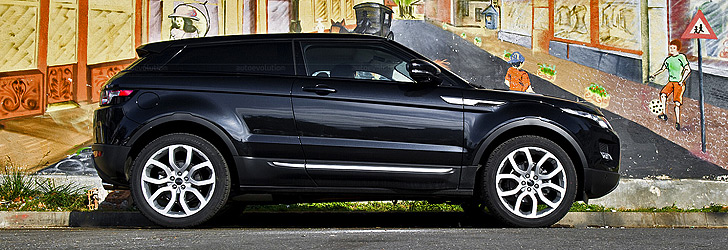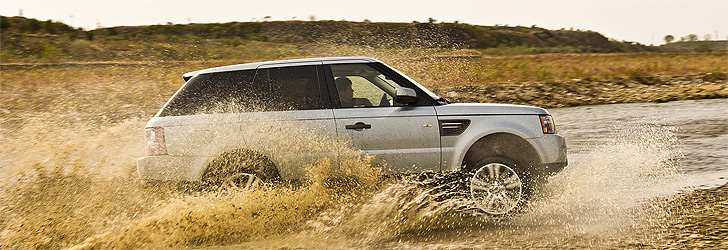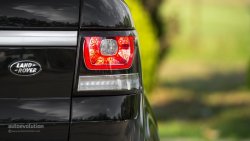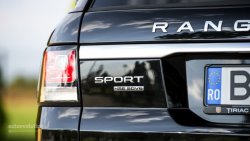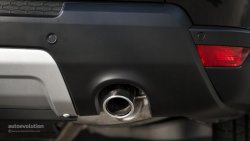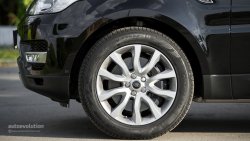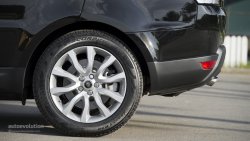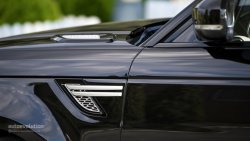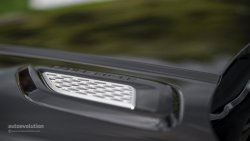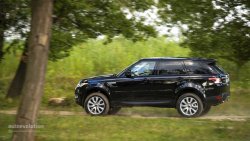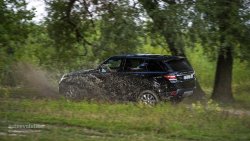2014 Range Rover Sport Review
OUR TEST CAR: 2014 LAND ROVER Range Rover Sport
The Range Rover Sport’s cabin somehow mirrors its exterior, displaying the same mélange of Range Rover and Range Rover Evoque elements. As far as this chapter is concerned, you notice this very quickly thanks to the driving position. This is a hybrid between those of the aforementioned models - you still get the commanding position of the chief model, but you sit much less upright.
The general feel of the car tells you this is a luxury SUV. If there’s something you can use against Porsche Cayenne owners, it’s the comfort. The soundproofing is exquisite and so is the ride.
You’re surrounded by acres of Land Rover’s sense-tickling leather and you’re looking out the window thinking this is a place you want to be in. On most roads, the Range Rover Sport knows how to make every journey a little present.
Alas, there certain areas where they preferred to be lazy with the changes and cover everything up with the “traditional approach” excuse. Perhaps you have to be at least 198 years old in order to understand why the front seats still have to come with those awful manually-powered armrests. As for the seats themselves, these seem to offer about the same comfort as those in the Range Rover, but come with superior side support.
Then there are the headrests, whose firmness led us to believe they were stolen from a racecar. In fact the padding all around the vehicle is rather frugal. Perhaps they should throw a look at Lexus’ way of making things soft around the cabin.
Body and Chassis
Just like the Range Rover, the Range Rover Sport features an all-aluminum monocoque that uses the platform of the Jaguar XJ as a starting point. Despite the fact that the eye may not perceive a hefty difference in dimension compared to the Range Rover, the Sport is 5.9 inches (149 mm) shorter and 2.2 inches (55 mm) lower. The Range Rover Sport also weighs 100 lbs (45 kg) less.
The old Range Rover Sport used an Integrated Body Frame platform, a hybrid between a ladder chassis and an unibody construction. We’re glad that the aforementioned platform is confined to the revamped 2014 Land Rover Discovery / LR4 now. That’s because the new aluminum design brings a weight benefit of about 800 lbs (360 kg), as well as a 39 percent increase in rigidity.
Powertrain
When it comes to novelties under the hood, the Range Rover Sport comes with a 3.0-liter supercharged V6 delivering 340 HP - we drove a beefed-up version of the unit on the Jaguar F-Type. Thus, the naturally-aspirated 5.0-liter V8 was put to sleep, as the new V6 replaces it.
There’s also a new diesel-hybrid, with the powertrain consisting of a 335 HP 3.0-liter V6 diesel and a 47 hp electric motor. Like the entire engine line-up, this features the eight-speed ZF automatic transmission. This covers the 0 to 62 mph sprint in 6.7 seconds, while returning an efficiency of 36 mpg (6.5 liters per 100 km). Thus, we have performance at a SDV8 diesel level with efficiency superior to the entry-level 258 HP V6 diesel. For now, there are no plans to bring the hybrid to the US though.
Regardless of the unit, the power is delivered via ZF-s eight-speed automatic transmission, a brilliant piece of kit that does it job in a discreet and lucrative manner.
Road Connection
The Range Rover Sport now features an aluminum suspension with a double-wishbone setup for the front axle and a multi-link layout at the rear. One of the goals here was to deliver the best wheel travel - 10.2 inches (260 mm) up front and 10.7 inches (272 mm) at the back.
The air suspension was reworked and now the range of height adjustments is greater than before. Between the Access Height and the standard off-road height you have 4.5 inches (115 mm), while the highest suspension settings adds a further 1.4 inches (35 mm).
There’s also an all-new Electric Power Assisted Steering, which needs three turns to go from lock to lock.
Stopping Power
The less powerful models, or those fitted with 19-inch wheels, feature a braking system consisting of 360 mm front discs and 350 mm rear rotors. In addition, the Range Rover Sport offers 380 mm discs with six-piston Brembo calipers up front and 365 mm rear discs.
The Range Rover Sport is the kind of car you’ll remember in terms of gadgets, albeit following both positive and negative experiences. We’ll mention the parts we liked first and we’re referring to the new elements here.
You can fit your Range Rover Sport with a head-up display that relies on laser technology. Joining a list of other carmakers that offer such a safety feature, Land Rover offers a Traffic Sign Recognition system, a toy you'll never want to let go after experiencing it.
Having covered the open road area with the aforementioned goodies, the Range Rover Sport also takes care of the city bits. The vehicle now has six parking sensors instead of four, with these being used for the new Flank Guard system. This warns the driver about potential side impacts in tight areas. It only does this when you’re heading towards them, ignoring objects that are just close. When you’re leaving the shopping mall with its miniature spaces, you’ll be really thankful for this.
Then there’s the updated Park Assist, which now also allows the car to park itself using perpendicular maneuvers, not just parallel ones.
Being a Range Rover, it also had to throw some new tech at the offloading sections and here’s where the Wade Sensing comes into play. Relying on sensors placed in the door mirrors, this offers visual and audible alerts as the water around the car climbs.
As for the unpleasant side of this story, this comes in the form of the infotainment system. Land Rover and Jaguar’s models currently share this issue, with their systems simply not managing to impress. For example, the satnav had a delay that meant we had to spend a few seconds typing each letter of a city’s name.
Fortunately, their British spirit meant they used a smooth feminine voice for the navigation. We really would’ve liked to give her an audio book.
Our tester had a three-zone climate control system, but the controls in the rear led one to believe that there are actually two zones over there. To see two rear passengers playing Ping-Pong with the temperature controls was a pretty sinister joke.
Fortunately, the audio system is quite a thrill. In the Range Rover Sport, you can choose between three Meridian systems. The best one offers 1,700W through 23 speakers. This provides an enchanting clarity at everyday volume. The automotive audio industry has turned to some sort of patriotic pathway lately. To stick to this pattern, we’ll tell you that Meridian’s crown jewels are up there with one the best effort of the Germans, the Burmester system on the Porsche Cayenne. However, we can’t help but mention that both are a bit below what Bang & Olufsen have to offer.
When it comes to providing safety, the Range Rover Sport is a mixture of shining and uninspiring elements. We’ll start with the good bits, which are led by the new aluminum chassis, one that’s 39 percent stiffer than the steel structure of the past generation.
In between the metallic bits, Land Rover has placed about one ton of electronics destined to take care of active safety. From Roll Stability Control, through Engine Drag Torque Control and Corner Brake Control, this thing is there to keep you from having to use the aforementioned chassis strength.
The vehicle hasn’t been tested by any international safety body so far, but one could remember the big picture of the Range Rover’s Euro NCAP results: five stars and a 91 percent adult occupant protection rating.
Nevertheless, if we are to dig a little deeper in the Range Rover’s Euro NCAP test results, we’ll find a marginal protection rating for the side pole impact and rear impact whiplash injuries.
And that’s not all, because the driving experience itself isn’t as safe as you would expect. Many of the customers will order the models that don’t come with Brembo brakes or adaptive suspension. In such a trim, the Range Rover Sport doesn’t inspire too much confidence once you get up to highway speeds. And if the mediocre feeling you get when performing an emergency braking won’t bother you, the serious body roll will.
You have to be generous when configuring your Range Rover Sport if you want this to be a truly safe vehicle.
Land Rover has done its homework with the second-generation Range Rover Sport. This time around, they’ve done everything right. Perhaps they’ve done it too well, bringing the Range Rover Sport interestingly close to the Range Rover - the gap between the two was tightened as the former climbed high compared to the previous generation, while the latter seems to have lost a bit of the prestige.
Land Rover isn't worried though. The comapny is confident that each has its own customers. They seem to be right, as the choice is usually made based on financial motives, as well as traditional vs. new-age taste.
Nevertheless, we can’t say the Range Rover Sport does things much differently than its predecessor. It’s more of a refinement process than a revolution. This all-round enhancement makes the character of the Range Rover Sport shine through even more.
This British attitude makes up the best part of the car. It’s the thing that differentiates it the most from its German rivals. Actually, the Mercedes-Benz ML seems to be the closest rival for the Range Rover Sport. Make no mistake though, the target audience is definitely different.
However, one could be sent to the Germans by the Range Rover Sport’s greatest flaw. The Brit is brilliant off the road, but when you’re on the tarmac things are different. Driving it, you never manage to escape the feeling you’re in a heavy, high-riding vehicle.
What’s more, there a few typical Range Rover sides that can become bothering. At the top of the list we find the infotainment system, which feels outdated.
In America, the Range Rover Sport starts at $63,495, but if we want to compare it with the Range Rover, we have to jump to the Supercharged model, as this is where the latter’s US range begins. Here, the Range Rover Sport will set you back at least $79,995, while the Range Rover only costs about $3,500 more. This is the only exception to the serious financial gap between the two.
If you go for the Range Rover Sport Autobiography range-topper, be prepared to spend at least $93,295 and an extra $42,700 for the Range Rover Autobiography.
As for the European pricing, the Range Rover Sport starts at EUR59,600, which gets you the 258 HP 3-liter diesel. The Supercharged model comes with a starting price of EUR88,300. The similar Range rover models cost EUR74,873 and EUR113,600, respectively.
The general feel of the car tells you this is a luxury SUV. If there’s something you can use against Porsche Cayenne owners, it’s the comfort. The soundproofing is exquisite and so is the ride.
You’re surrounded by acres of Land Rover’s sense-tickling leather and you’re looking out the window thinking this is a place you want to be in. On most roads, the Range Rover Sport knows how to make every journey a little present.
Alas, there certain areas where they preferred to be lazy with the changes and cover everything up with the “traditional approach” excuse. Perhaps you have to be at least 198 years old in order to understand why the front seats still have to come with those awful manually-powered armrests. As for the seats themselves, these seem to offer about the same comfort as those in the Range Rover, but come with superior side support.
Then there are the headrests, whose firmness led us to believe they were stolen from a racecar. In fact the padding all around the vehicle is rather frugal. Perhaps they should throw a look at Lexus’ way of making things soft around the cabin.
Body and Chassis
Just like the Range Rover, the Range Rover Sport features an all-aluminum monocoque that uses the platform of the Jaguar XJ as a starting point. Despite the fact that the eye may not perceive a hefty difference in dimension compared to the Range Rover, the Sport is 5.9 inches (149 mm) shorter and 2.2 inches (55 mm) lower. The Range Rover Sport also weighs 100 lbs (45 kg) less.
The old Range Rover Sport used an Integrated Body Frame platform, a hybrid between a ladder chassis and an unibody construction. We’re glad that the aforementioned platform is confined to the revamped 2014 Land Rover Discovery / LR4 now. That’s because the new aluminum design brings a weight benefit of about 800 lbs (360 kg), as well as a 39 percent increase in rigidity.
Powertrain
When it comes to novelties under the hood, the Range Rover Sport comes with a 3.0-liter supercharged V6 delivering 340 HP - we drove a beefed-up version of the unit on the Jaguar F-Type. Thus, the naturally-aspirated 5.0-liter V8 was put to sleep, as the new V6 replaces it.
There’s also a new diesel-hybrid, with the powertrain consisting of a 335 HP 3.0-liter V6 diesel and a 47 hp electric motor. Like the entire engine line-up, this features the eight-speed ZF automatic transmission. This covers the 0 to 62 mph sprint in 6.7 seconds, while returning an efficiency of 36 mpg (6.5 liters per 100 km). Thus, we have performance at a SDV8 diesel level with efficiency superior to the entry-level 258 HP V6 diesel. For now, there are no plans to bring the hybrid to the US though.
Regardless of the unit, the power is delivered via ZF-s eight-speed automatic transmission, a brilliant piece of kit that does it job in a discreet and lucrative manner.
Road Connection
The Range Rover Sport now features an aluminum suspension with a double-wishbone setup for the front axle and a multi-link layout at the rear. One of the goals here was to deliver the best wheel travel - 10.2 inches (260 mm) up front and 10.7 inches (272 mm) at the back.
The air suspension was reworked and now the range of height adjustments is greater than before. Between the Access Height and the standard off-road height you have 4.5 inches (115 mm), while the highest suspension settings adds a further 1.4 inches (35 mm).
There’s also an all-new Electric Power Assisted Steering, which needs three turns to go from lock to lock.
Stopping Power
The less powerful models, or those fitted with 19-inch wheels, feature a braking system consisting of 360 mm front discs and 350 mm rear rotors. In addition, the Range Rover Sport offers 380 mm discs with six-piston Brembo calipers up front and 365 mm rear discs.
The Range Rover Sport is the kind of car you’ll remember in terms of gadgets, albeit following both positive and negative experiences. We’ll mention the parts we liked first and we’re referring to the new elements here.
You can fit your Range Rover Sport with a head-up display that relies on laser technology. Joining a list of other carmakers that offer such a safety feature, Land Rover offers a Traffic Sign Recognition system, a toy you'll never want to let go after experiencing it.
Having covered the open road area with the aforementioned goodies, the Range Rover Sport also takes care of the city bits. The vehicle now has six parking sensors instead of four, with these being used for the new Flank Guard system. This warns the driver about potential side impacts in tight areas. It only does this when you’re heading towards them, ignoring objects that are just close. When you’re leaving the shopping mall with its miniature spaces, you’ll be really thankful for this.
Then there’s the updated Park Assist, which now also allows the car to park itself using perpendicular maneuvers, not just parallel ones.
Being a Range Rover, it also had to throw some new tech at the offloading sections and here’s where the Wade Sensing comes into play. Relying on sensors placed in the door mirrors, this offers visual and audible alerts as the water around the car climbs.
As for the unpleasant side of this story, this comes in the form of the infotainment system. Land Rover and Jaguar’s models currently share this issue, with their systems simply not managing to impress. For example, the satnav had a delay that meant we had to spend a few seconds typing each letter of a city’s name.
Fortunately, their British spirit meant they used a smooth feminine voice for the navigation. We really would’ve liked to give her an audio book.
Our tester had a three-zone climate control system, but the controls in the rear led one to believe that there are actually two zones over there. To see two rear passengers playing Ping-Pong with the temperature controls was a pretty sinister joke.
Fortunately, the audio system is quite a thrill. In the Range Rover Sport, you can choose between three Meridian systems. The best one offers 1,700W through 23 speakers. This provides an enchanting clarity at everyday volume. The automotive audio industry has turned to some sort of patriotic pathway lately. To stick to this pattern, we’ll tell you that Meridian’s crown jewels are up there with one the best effort of the Germans, the Burmester system on the Porsche Cayenne. However, we can’t help but mention that both are a bit below what Bang & Olufsen have to offer.
When it comes to providing safety, the Range Rover Sport is a mixture of shining and uninspiring elements. We’ll start with the good bits, which are led by the new aluminum chassis, one that’s 39 percent stiffer than the steel structure of the past generation.
In between the metallic bits, Land Rover has placed about one ton of electronics destined to take care of active safety. From Roll Stability Control, through Engine Drag Torque Control and Corner Brake Control, this thing is there to keep you from having to use the aforementioned chassis strength.
The vehicle hasn’t been tested by any international safety body so far, but one could remember the big picture of the Range Rover’s Euro NCAP results: five stars and a 91 percent adult occupant protection rating.
Nevertheless, if we are to dig a little deeper in the Range Rover’s Euro NCAP test results, we’ll find a marginal protection rating for the side pole impact and rear impact whiplash injuries.
And that’s not all, because the driving experience itself isn’t as safe as you would expect. Many of the customers will order the models that don’t come with Brembo brakes or adaptive suspension. In such a trim, the Range Rover Sport doesn’t inspire too much confidence once you get up to highway speeds. And if the mediocre feeling you get when performing an emergency braking won’t bother you, the serious body roll will.
You have to be generous when configuring your Range Rover Sport if you want this to be a truly safe vehicle.
Land Rover has done its homework with the second-generation Range Rover Sport. This time around, they’ve done everything right. Perhaps they’ve done it too well, bringing the Range Rover Sport interestingly close to the Range Rover - the gap between the two was tightened as the former climbed high compared to the previous generation, while the latter seems to have lost a bit of the prestige.
Land Rover isn't worried though. The comapny is confident that each has its own customers. They seem to be right, as the choice is usually made based on financial motives, as well as traditional vs. new-age taste.
Nevertheless, we can’t say the Range Rover Sport does things much differently than its predecessor. It’s more of a refinement process than a revolution. This all-round enhancement makes the character of the Range Rover Sport shine through even more.
This British attitude makes up the best part of the car. It’s the thing that differentiates it the most from its German rivals. Actually, the Mercedes-Benz ML seems to be the closest rival for the Range Rover Sport. Make no mistake though, the target audience is definitely different.
However, one could be sent to the Germans by the Range Rover Sport’s greatest flaw. The Brit is brilliant off the road, but when you’re on the tarmac things are different. Driving it, you never manage to escape the feeling you’re in a heavy, high-riding vehicle.
What’s more, there a few typical Range Rover sides that can become bothering. At the top of the list we find the infotainment system, which feels outdated.
In America, the Range Rover Sport starts at $63,495, but if we want to compare it with the Range Rover, we have to jump to the Supercharged model, as this is where the latter’s US range begins. Here, the Range Rover Sport will set you back at least $79,995, while the Range Rover only costs about $3,500 more. This is the only exception to the serious financial gap between the two.
If you go for the Range Rover Sport Autobiography range-topper, be prepared to spend at least $93,295 and an extra $42,700 for the Range Rover Autobiography.
As for the European pricing, the Range Rover Sport starts at EUR59,600, which gets you the 258 HP 3-liter diesel. The Supercharged model comes with a starting price of EUR88,300. The similar Range rover models cost EUR74,873 and EUR113,600, respectively.
THE END
12
Our LAND ROVER Testdrives:
Photo gallery (80)
